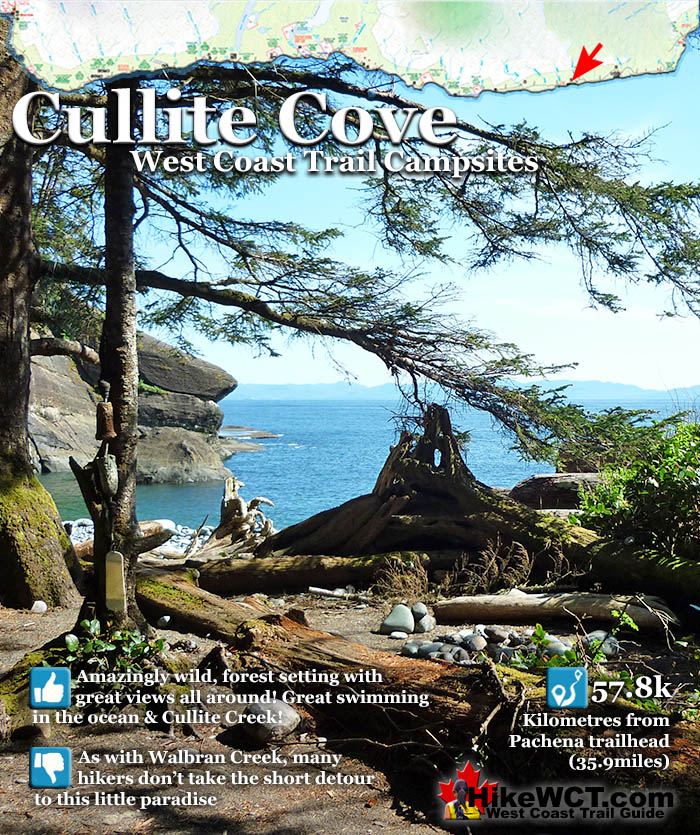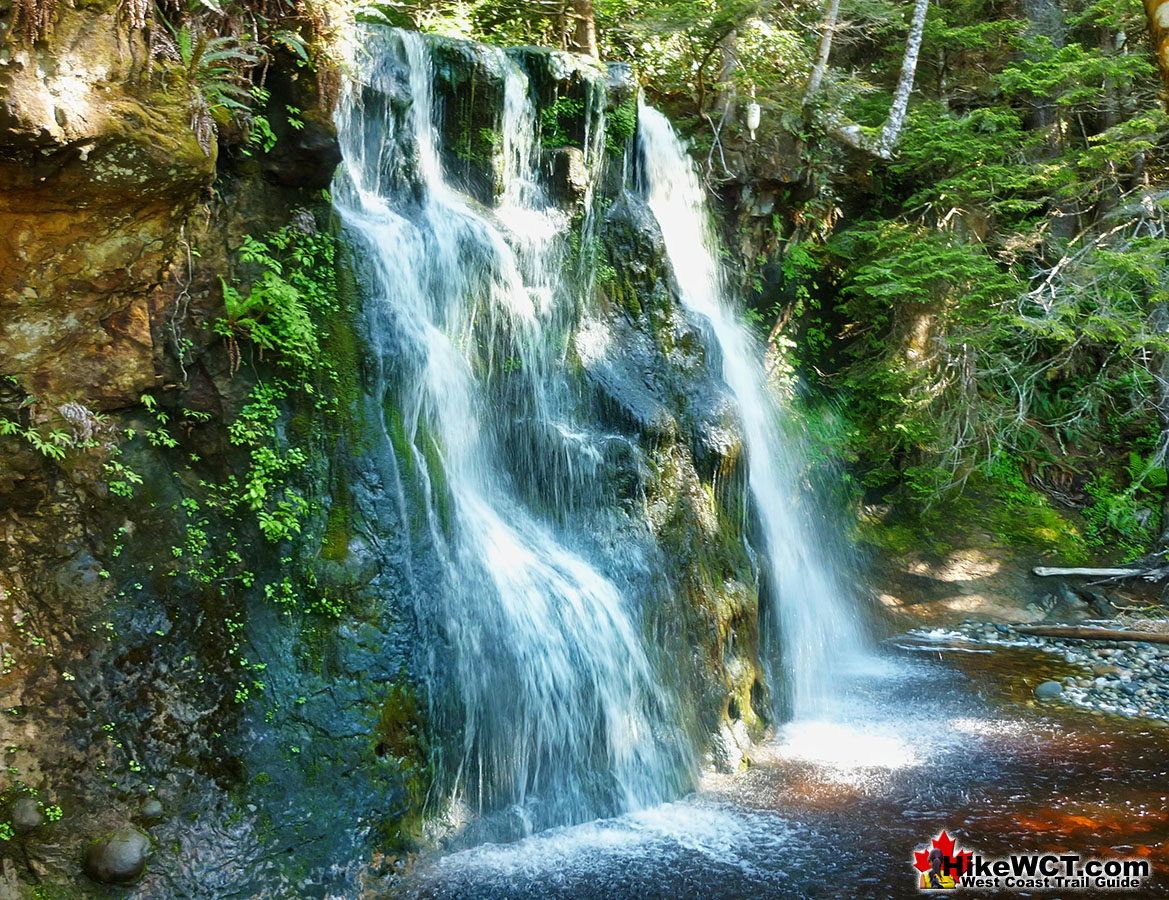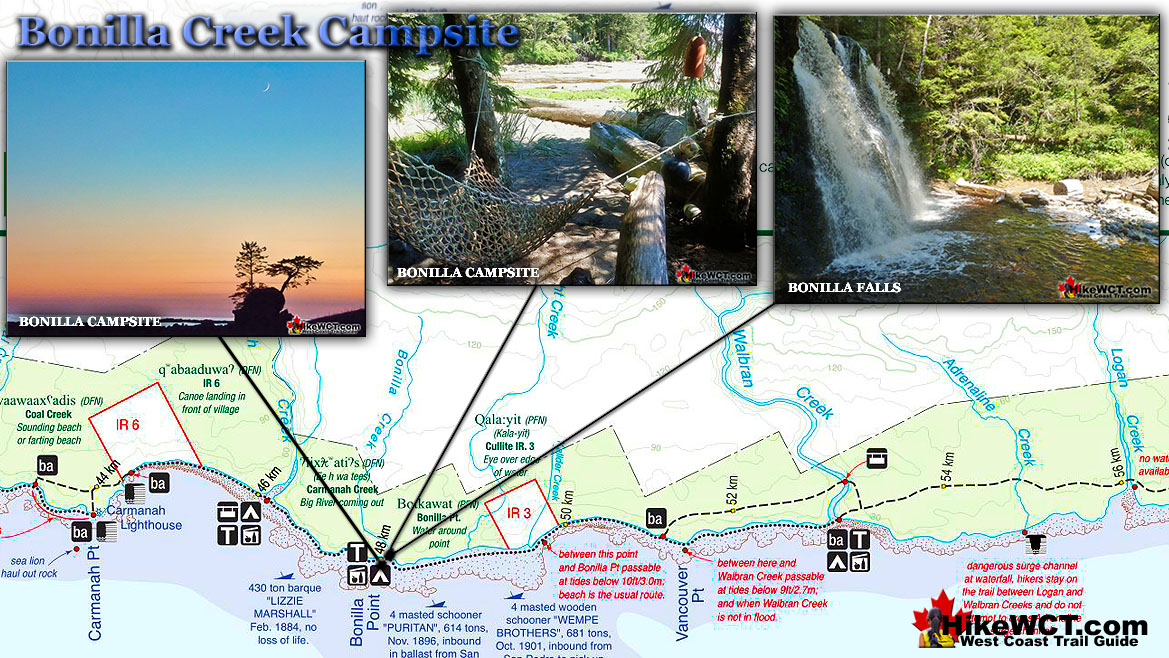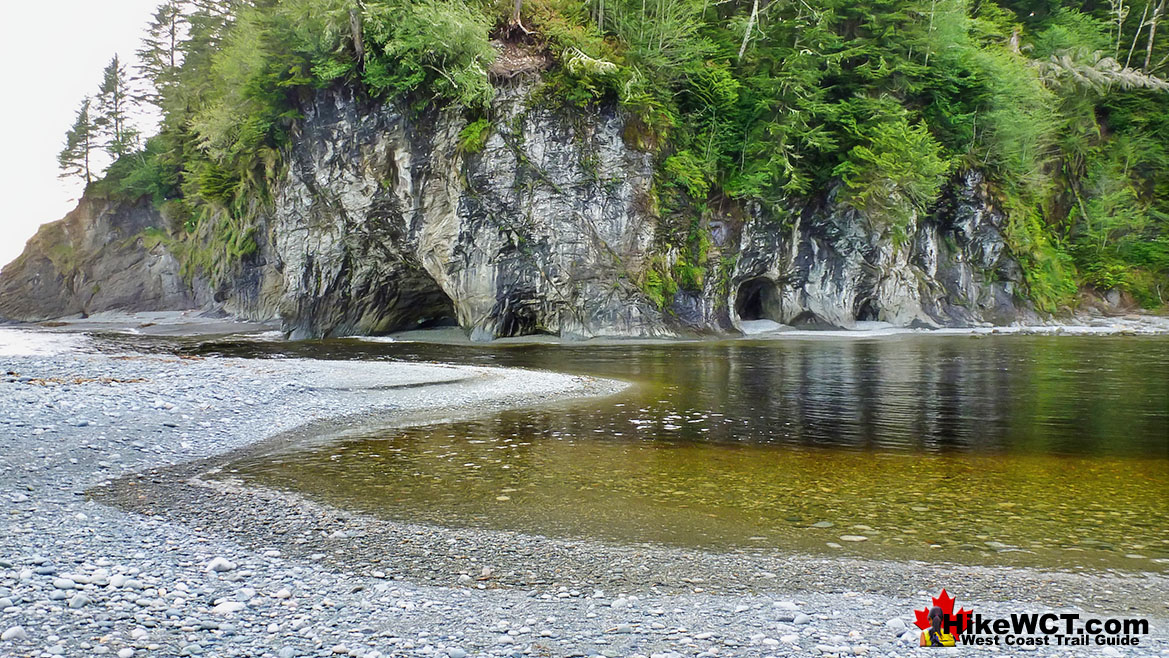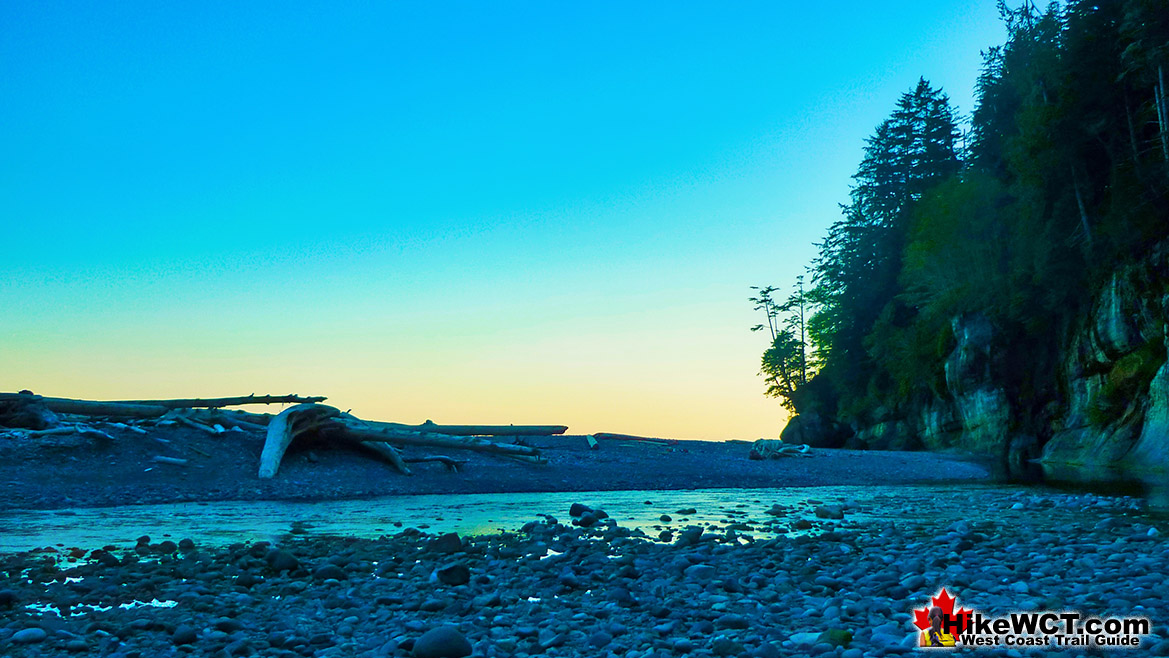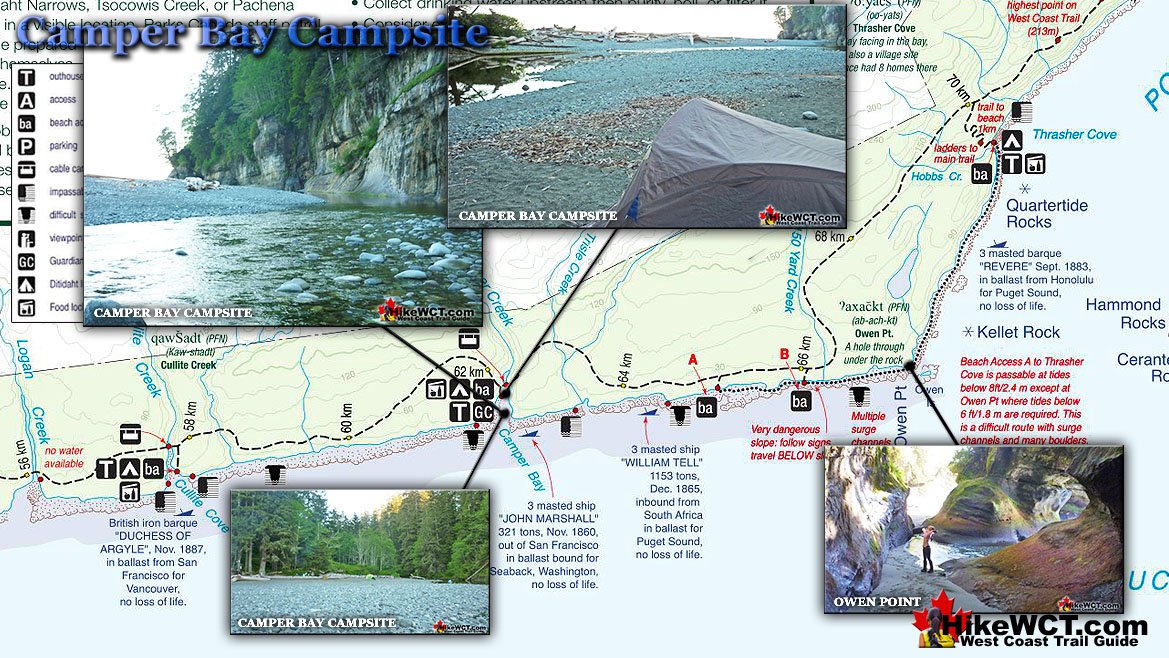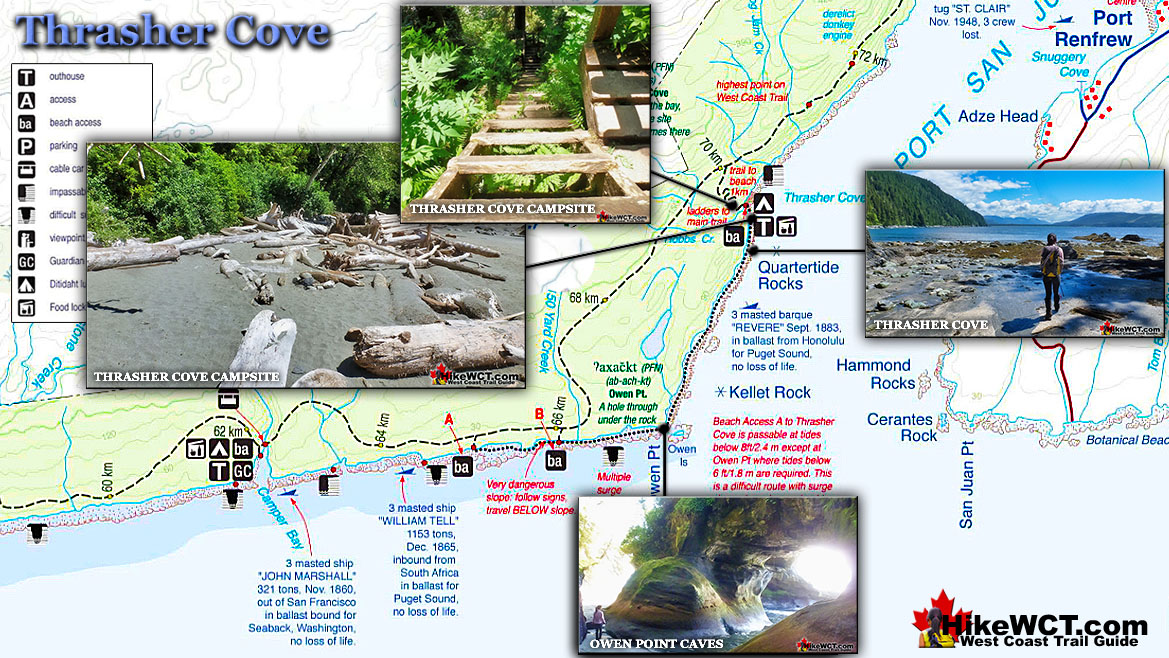![]() Cullite Cove is a wonderful campsite on the West Coast Trail at the 58 kilometre mark. One of the nicest campsites that has everything, a lovely wooded area with clearings for tents and campfires, stunning views all around. A terrific, pebble beach, beautifully hemmed in by towering cliffs on either side.
Cullite Cove is a wonderful campsite on the West Coast Trail at the 58 kilometre mark. One of the nicest campsites that has everything, a lovely wooded area with clearings for tents and campfires, stunning views all around. A terrific, pebble beach, beautifully hemmed in by towering cliffs on either side.
 Nice, smooth rock beach flanked by cliffs
Nice, smooth rock beach flanked by cliffs Very nice tent sites in the forest
Very nice tent sites in the forest Great views everywhere you look
Great views everywhere you look Quiet campsite as most camp at Camper Bay
Quiet campsite as most camp at Camper Bay Most hikers don't detour down to Cullite Cove
Most hikers don't detour down to Cullite Cove Your tent always has a million dollar view!
Your tent always has a million dollar view! Cullite Creek is big, clean and very scenic
Cullite Creek is big, clean and very scenic Mini beaches line both sides of the creek
Mini beaches line both sides of the creek Cullite Creek is wonderful to swim in
Cullite Creek is wonderful to swim in Boats pass the cove often and loudly
Boats pass the cove often and loudly
West Coast Trail Campsites
![]() Michigan Creek at 12km
Michigan Creek at 12km ![]() Darling River at 14km
Darling River at 14km ![]() Orange Juice Creek at 15km
Orange Juice Creek at 15km ![]() Tsocowis Creek at 16.5km
Tsocowis Creek at 16.5km ![]() Klanawa River at 23km
Klanawa River at 23km ![]() Tsusiat Falls at 25km
Tsusiat Falls at 25km ![]() Cribs Creek at 42km
Cribs Creek at 42km ![]() Carmanah Creek at 46km
Carmanah Creek at 46km ![]() Bonilla Creek at 48km
Bonilla Creek at 48km ![]() Walbran Creek at 53km
Walbran Creek at 53km ![]() Cullite Cove at 58km
Cullite Cove at 58km ![]() Camper Bay at 62km
Camper Bay at 62km ![]() Thrasher Cove at 70km
Thrasher Cove at 70km
Cullite Creek pours into the cove, making for a stunning, albeit cold swim into the surf. Cullite Cove is a close to perfect as a West Coast Trail campsite can get. The creek is beautiful, crystal clear, bright green, big and slow moving into Cullite Cove. A picture perfect beach hemmed in by majestic cliffs on both sides. The forest is a wonderful tangle of trees extending up to some of the most challenging sections of the West Coast Trail. In both direction on the trail you encounter some of the longest ladders on the trail. Very exhilarating, but also a bit bewildering as you can't help but wonder how a trail could develop in such absurdly rugged terrain. With ladders everywhere the trail is still very challenging. Before the ladders, it must have been a nightmare. It is this section of the West Coast Trail that makes people fall in love with it. It is hard. Very hard. And you never quite know what is around the next bend in the trail or at the top of a ladder. Plenty of times you will climb an impossibly long ladder, only to come to a small platform and another ladder as long as the first!
Beautiful Cullite Cove on the West Coast Trail

Ladders To and From Cullite Cove
Other times you will emerge from deep forest to find yourself at a vertical cliff with a slippery, old wooden ladder disappearing over the edge. As you climb down and try not to imagine falling from such a height, you marvel at how beautiful and wild everything is. At the bottom, you look up the ladder and wonder if that was the longest ladder on the trail. You conclude it must be, only to find another longer and more terrifying ladder a few minutes later! This is what the trail is like in both directions from Cullite Cove. Brutal, exhausting, relentlessly difficult, and unquestionably wonderful. All the time you are carrying 60 pounds on your back.
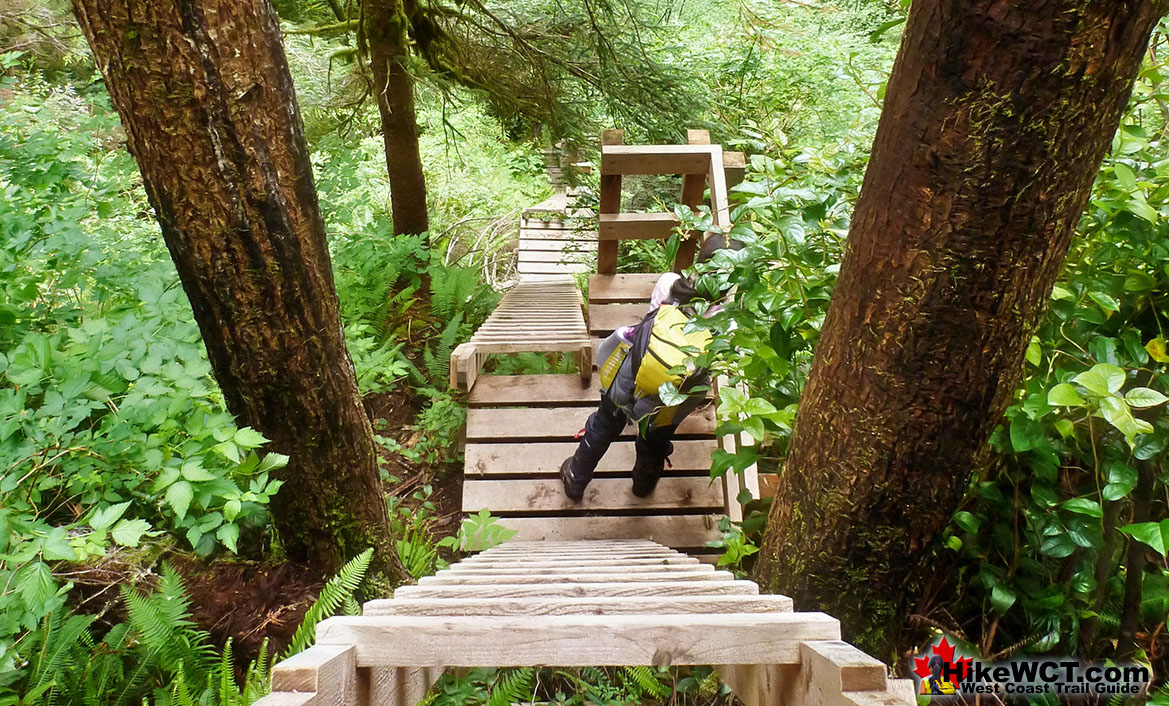
Cullite Creek at Dusk
Cullite Creek passes alongside the forest campsites and through the smooth, pebble beach into the ocean. Pebble beaches have a great advantage over sandy beaches in that you don't track sand everywhere you go and especially in your tent.

Wonderful Cullite Cove Missed by Most Hikers
Despite the weight, your pack full of gear is everything you need to camp anywhere in this magnificent wilderness. If you want you can hike down to Cullite Cove and live in this snug little wilderness. So many exhausted hikers don't hike the 15 minute side trail down to the beach and idyllic tent clearings in the cove's perfect little forest. It is always a good idea to plan for hiking the trail a couple days longer than you think you might take as you have to relax and sink into this wonderful wilderness at the edge of the Graveyard of the Pacific. Just off the beach, several campsites are laid out, hidden in the trees. Your first thought on seeing the tent sites in Cullite Cove is to want to stay for a week. The campsite here is often very quiet as everybody seems to camp at Camper Bay just 4 kilometres away and don't even visit Cullite Cove.
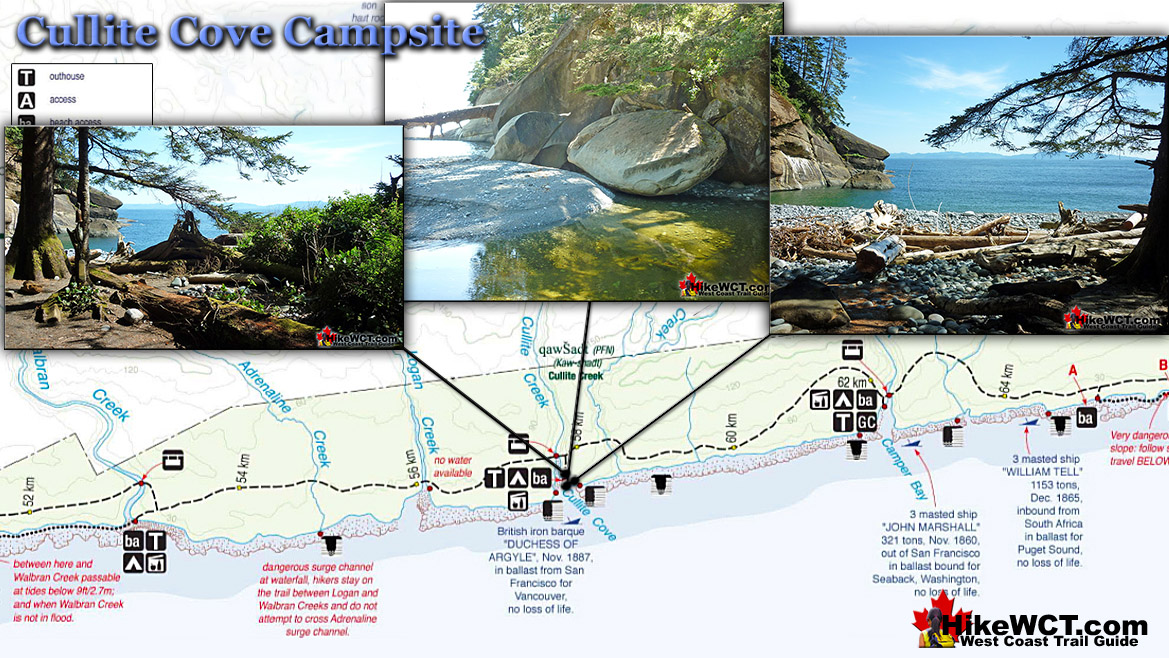
Cullite Cove Campsite is Amazing
The campsite at Cullite Cove is a perfect combination of many features. First, the tent clearings are all in a beautifully wild, West Coast Trail forest that is deep enough to feel sheltered, yet open enough to give you stunning views everywhere you look. The tall, sandstone cliffs on either side of Cullite Cove add to this great feeling that you are in a hidden world
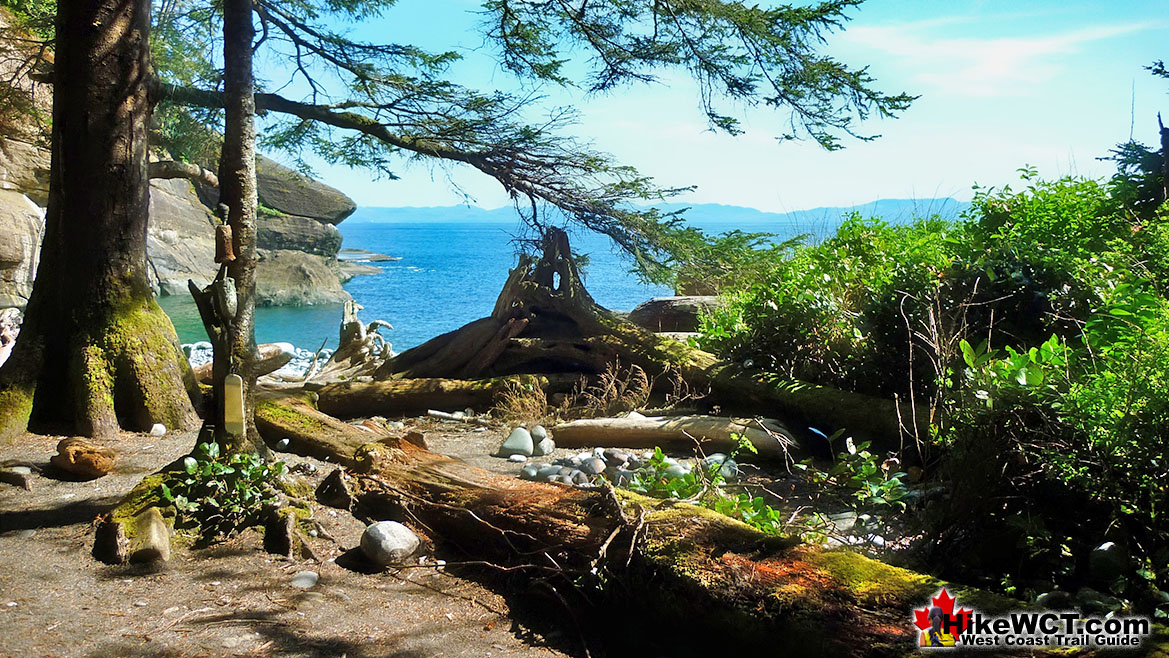
Spacious and Wild Cullite Cove Campsite
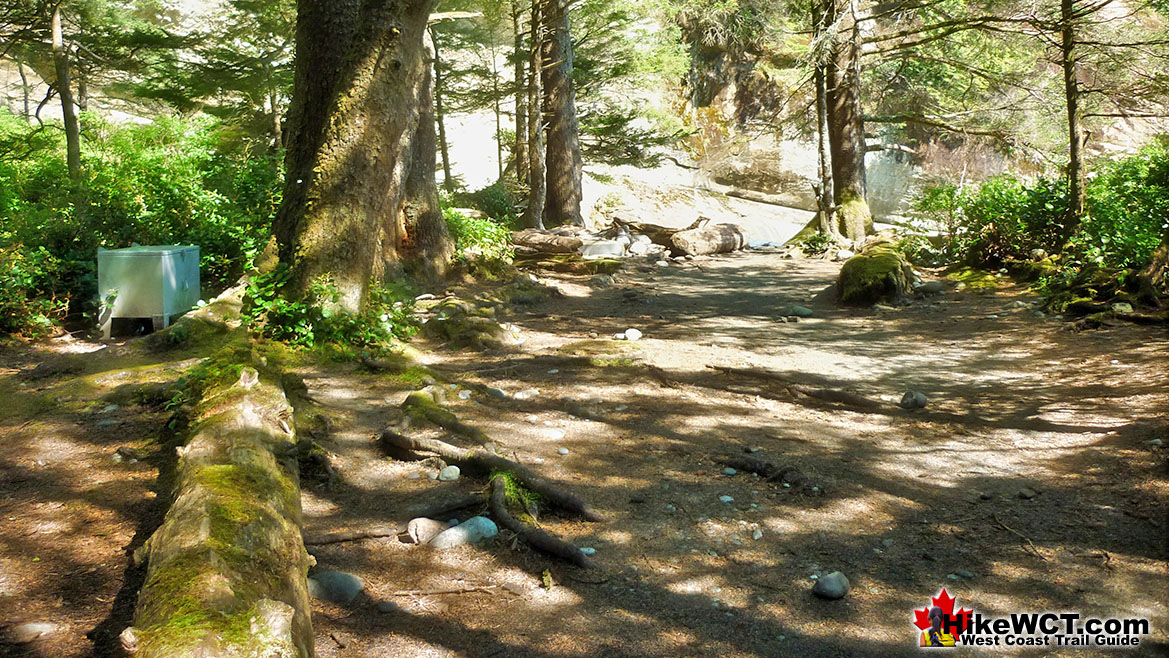
Cullite Cove beach is just steps from your tent. Sheltered and clean, the beach looks and feels amazingly clean compared to some other West Coast Trail campsite beaches that are a bit messy by comparison.
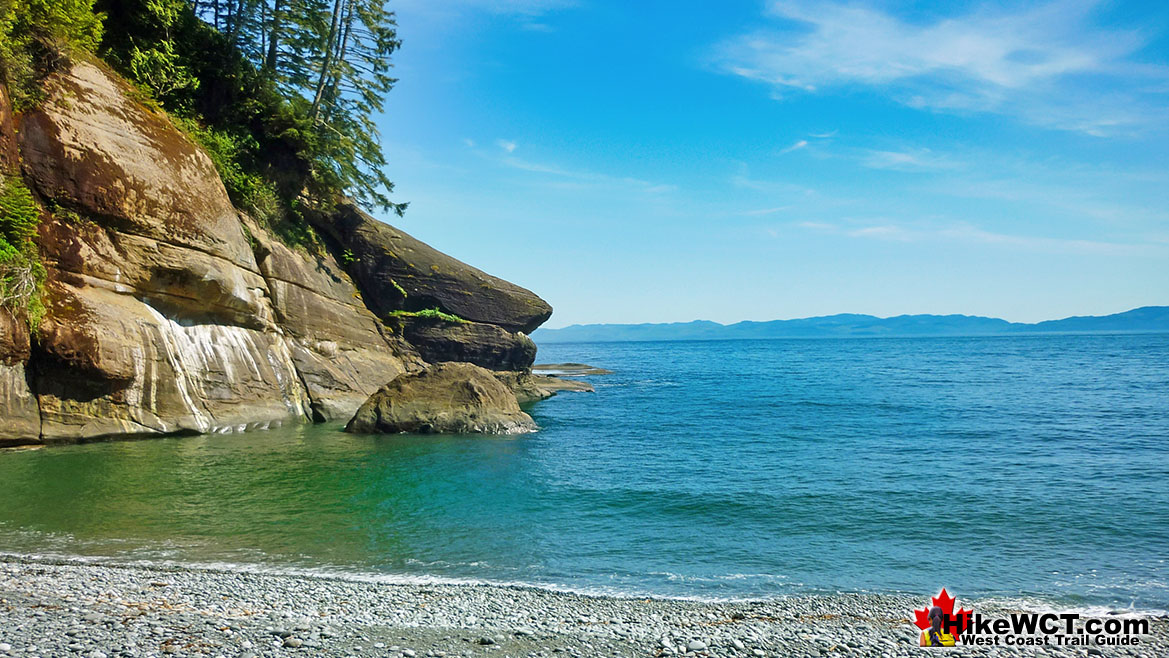
Cullite Creek flows through the beach along one side and is deep enough for a swim just a few metres back from the edge of the ocean.
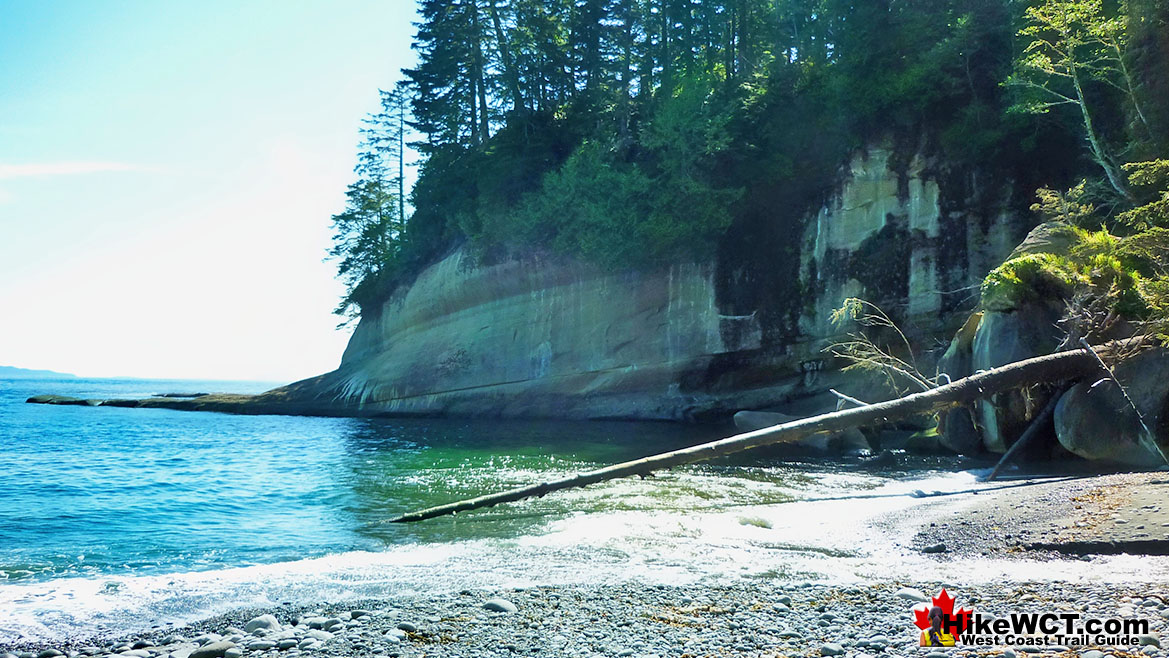
Cullite Creek hugs the vertical, sandstone cliff and you can easily cross the creek and wander around the massive, smooth, rounded boulders leaning menacingly against the cliffs.

Cullite Creek is a Hidden Paradise
Cullite Creek widens and extends back into the forest with huge, broad beaches on either side to wander through. On a sunny day, this place is a West Coast Trail bit of paradise. Tranquil, wild and beautiful. Most West Coast Trail hikers don't venture down the steep ladders from the main trail to even see it. And almost everybody camps at Camper Bay just 4 kilometres down the trail as it is an ideal hiking distance from the Gordon River trailhead.

Shipwrecks Near Cullite Cove
The Puritan Shipwreck Near KM48.5
![]() The Puritan was a 4 masted schooner of 614 tons sailing inbound from San Francisco in ballast. She was heading for Port Gamble in Washington to pick up a load of lumber when the crew failed to account for the strong current in Juan de Fuca Strait. Owing to the thick fog and heavy seas, the Puritan stumbled blindly into the rocks of Bonilla Point. The crew of 10 made the same mistake that hundreds of crews before them made. They didn't reckon their course with the notorious, strong current of the Juan de Fuca Strait. The current pushed them far northwest of their perceived position. Unable to see due to the thick fog, stormy weather and darkness of night the Puritan was pushed into the rocky Bonilla Point. The record shows that she was wrecked at 5am on November 13, 1896. The crew decided to wait for daybreak to figure out their escape. When the morning finally came, a local First Nations man found them, and battling the surf, managed to run a rope from the ship to the shore after hours of agonizing attempts, waist deep in the freezing ocean. The crew was then able to get a heavy rope to shore and rig a life-line to escape the crumbling ship. The Puritan, continuously bashed by the sea until on the following day she was laying her masts in the surf, and quickly began breaking up. The crew made their way to the Carmanah Point Lighthouse and later ferried to Victoria. For his heroic efforts, this incredibly heroic man was given a reward from the Canadian government. Today hiking the West Coast Trail, you will find some of the ship's remains on the outer reef.
The Puritan was a 4 masted schooner of 614 tons sailing inbound from San Francisco in ballast. She was heading for Port Gamble in Washington to pick up a load of lumber when the crew failed to account for the strong current in Juan de Fuca Strait. Owing to the thick fog and heavy seas, the Puritan stumbled blindly into the rocks of Bonilla Point. The crew of 10 made the same mistake that hundreds of crews before them made. They didn't reckon their course with the notorious, strong current of the Juan de Fuca Strait. The current pushed them far northwest of their perceived position. Unable to see due to the thick fog, stormy weather and darkness of night the Puritan was pushed into the rocky Bonilla Point. The record shows that she was wrecked at 5am on November 13, 1896. The crew decided to wait for daybreak to figure out their escape. When the morning finally came, a local First Nations man found them, and battling the surf, managed to run a rope from the ship to the shore after hours of agonizing attempts, waist deep in the freezing ocean. The crew was then able to get a heavy rope to shore and rig a life-line to escape the crumbling ship. The Puritan, continuously bashed by the sea until on the following day she was laying her masts in the surf, and quickly began breaking up. The crew made their way to the Carmanah Point Lighthouse and later ferried to Victoria. For his heroic efforts, this incredibly heroic man was given a reward from the Canadian government. Today hiking the West Coast Trail, you will find some of the ship's remains on the outer reef.
Puritan shipwreck continued here...
The Wempe Brothers Shipwreck Near KM49.4
![]() The Wempe Brothers was a 4 masted schooner just 70 tons heavier than the Puritan, that wrecked here a century ago. The Wempe Brothers was sailing in from San Pedro, California in ballast. She was heading for Puget Sound to pick up lumber when she was claimed by the Graveyard of the Pacific. The crew of 10 experienced very stormy weather as she neared the Cape Flattery Lighthouse and entrance to Juan de Fuca Strait. Light winds and thick fog carried them towards the strait, however the fast current pulled them irresistibly north towards the coast of Vancouver Island. The Wempe Brothers was carried so close to Carmanah Point Lighthouse that the lighthouse lights were reported to be reflected on the ships sails and hull. The crew had no idea they were so far out of their intended position and the sudden appearance of a lighthouse must have been terrifying. The wind was dead calm so sailing to safety was not an option. The crew managed to drop two anchors in a desperate effort to halt the ship before colliding with the shore. It was too late, however, as the Wempe Brothers was carried onto the beach at 5am on October 28th, 1903.
The Wempe Brothers was a 4 masted schooner just 70 tons heavier than the Puritan, that wrecked here a century ago. The Wempe Brothers was sailing in from San Pedro, California in ballast. She was heading for Puget Sound to pick up lumber when she was claimed by the Graveyard of the Pacific. The crew of 10 experienced very stormy weather as she neared the Cape Flattery Lighthouse and entrance to Juan de Fuca Strait. Light winds and thick fog carried them towards the strait, however the fast current pulled them irresistibly north towards the coast of Vancouver Island. The Wempe Brothers was carried so close to Carmanah Point Lighthouse that the lighthouse lights were reported to be reflected on the ships sails and hull. The crew had no idea they were so far out of their intended position and the sudden appearance of a lighthouse must have been terrifying. The wind was dead calm so sailing to safety was not an option. The crew managed to drop two anchors in a desperate effort to halt the ship before colliding with the shore. It was too late, however, as the Wempe Brothers was carried onto the beach at 5am on October 28th, 1903.
Wempe Brothers shipwreck continued here...
The Duchess of Argyle Shipwreck Near KM58
![]() The Duchess of Argyle met her end at the mouth of Cullite Cove back at the 58 kilometre mark of the West Coast Trail. She was a huge, four masted barque with an iron hull and watertight bulkheads. She was sailing in ballast from San Francisco on October 13th, 1887, bound for Vancouver. She would pick up lumber and sail for Melbourne, Australia. Sailing up the coast from San Francisco, the good weather turned bad on October 16th. For almost two weeks a powerful gale hammered the Duchess of Argyle. When the storm finally let up, Cape Flattery was sighted about 20 miles away. The ship, unable to find wind, floated with the current, inching towards Juan de Fuca Strait. Soon a small tug boat arrived to assist the enormous becalmed ship through the strait. They lowered sails and got the hawser aboard to connect the ships. The captain of the tug quickly realized that his vessel was too small to manage such a huge ship rolling in the seas. Cape Flattery was still about 14 miles distant and concealed by fog much of the time. The Duchess of Argyle wallowed in the current until midnight when a strong eastward gale gripped the ship once more. They sailed for Cape Flattery until the wind died again and on November 1st the fog lifted revealing Cape Flattery just 3 miles away. Suddenly the fog returned again, thicker than ever. They crawled forward slowly hoping for the fog to lift again. The fog didn't let up and at 315pm on November 3rd, breakers were heard...
The Duchess of Argyle met her end at the mouth of Cullite Cove back at the 58 kilometre mark of the West Coast Trail. She was a huge, four masted barque with an iron hull and watertight bulkheads. She was sailing in ballast from San Francisco on October 13th, 1887, bound for Vancouver. She would pick up lumber and sail for Melbourne, Australia. Sailing up the coast from San Francisco, the good weather turned bad on October 16th. For almost two weeks a powerful gale hammered the Duchess of Argyle. When the storm finally let up, Cape Flattery was sighted about 20 miles away. The ship, unable to find wind, floated with the current, inching towards Juan de Fuca Strait. Soon a small tug boat arrived to assist the enormous becalmed ship through the strait. They lowered sails and got the hawser aboard to connect the ships. The captain of the tug quickly realized that his vessel was too small to manage such a huge ship rolling in the seas. Cape Flattery was still about 14 miles distant and concealed by fog much of the time. The Duchess of Argyle wallowed in the current until midnight when a strong eastward gale gripped the ship once more. They sailed for Cape Flattery until the wind died again and on November 1st the fog lifted revealing Cape Flattery just 3 miles away. Suddenly the fog returned again, thicker than ever. They crawled forward slowly hoping for the fog to lift again. The fog didn't let up and at 315pm on November 3rd, breakers were heard...
Duchess of Argyle shipwreck continued here...
The John Marshall Shipwreck Near KM62
![]() The John Marshall shipwreck is located under the waves just outside the mouth of Camper Bay near the 62 kilometre mark of the West Coast Trail. Owing to the great difficulty and slow progress hikers are forced to take on this section of the West Coast Trail, nearly everyone camps at Camper Creek. If you do, you will be sleeping near this shipwreck that occurred here in 1860. The John Marshall was an old eastern built, 3 masted ship of 321 tons. Sailing in from San Francisco with a crew of 10, she was heading to Seabeck, Washington in ballast to pick up a load of lumber. Off Cape Flattery the John Marshall met a raging storm that left her beached in front of Camper Bay. There seem to be few details of this shipwreck, however, local natives reported that two ships came ashore from the storm that night. It had been assumed that she foundered off Cape Flattery with no survivors. So it was quite a surprise to find her ashore at Camper Bay, with her hull visible at low tide and her masts, spars and rigging scattered on the beach. There are no details of deaths from this shipwreck, so it is assumed that there was no loss of life.
The John Marshall shipwreck is located under the waves just outside the mouth of Camper Bay near the 62 kilometre mark of the West Coast Trail. Owing to the great difficulty and slow progress hikers are forced to take on this section of the West Coast Trail, nearly everyone camps at Camper Creek. If you do, you will be sleeping near this shipwreck that occurred here in 1860. The John Marshall was an old eastern built, 3 masted ship of 321 tons. Sailing in from San Francisco with a crew of 10, she was heading to Seabeck, Washington in ballast to pick up a load of lumber. Off Cape Flattery the John Marshall met a raging storm that left her beached in front of Camper Bay. There seem to be few details of this shipwreck, however, local natives reported that two ships came ashore from the storm that night. It had been assumed that she foundered off Cape Flattery with no survivors. So it was quite a surprise to find her ashore at Camper Bay, with her hull visible at low tide and her masts, spars and rigging scattered on the beach. There are no details of deaths from this shipwreck, so it is assumed that there was no loss of life.
John Marshall shipwreck continued here...
The William Tell Shipwreck Near KM64
![]() Less than a kilometre past the John Marshall shipwreck you will pass the William Tell shipwreck. Considerably larger than the John Marshall, the William Tell was a 1153 ton, 3 masted ship that wrecked in the Graveyard of the Pacific on December 23rd, 1865. She sailed straight into the reef in front of what is now the 64 kilometre mark of the West Coast Trail. The William Tell was built in New York in 1850. She sailed in the North Atlantic for a few years before branching out to more distant ports. On her final voyage in 1865, she was inbound from South Africa in ballast, heading to a port in the Puget Sound. She managed to sail into Juan de Fuca Strait, however stormy weather and strong currents moved her considerably far west. Blindly sailing in thick fog and the darkness of night, the William Tell smashed into the reef between Owen Point and Camper Bay. The crew of 22 men managed to scramble safely to shore and made their way to Owen Point where they lit signal fires. Their fires were spotted from the harbour of Port San Juan(Port Renfrew). They were picked up and later brought back to Victoria by a local trading schooner.
Less than a kilometre past the John Marshall shipwreck you will pass the William Tell shipwreck. Considerably larger than the John Marshall, the William Tell was a 1153 ton, 3 masted ship that wrecked in the Graveyard of the Pacific on December 23rd, 1865. She sailed straight into the reef in front of what is now the 64 kilometre mark of the West Coast Trail. The William Tell was built in New York in 1850. She sailed in the North Atlantic for a few years before branching out to more distant ports. On her final voyage in 1865, she was inbound from South Africa in ballast, heading to a port in the Puget Sound. She managed to sail into Juan de Fuca Strait, however stormy weather and strong currents moved her considerably far west. Blindly sailing in thick fog and the darkness of night, the William Tell smashed into the reef between Owen Point and Camper Bay. The crew of 22 men managed to scramble safely to shore and made their way to Owen Point where they lit signal fires. Their fires were spotted from the harbour of Port San Juan(Port Renfrew). They were picked up and later brought back to Victoria by a local trading schooner.
William Tell shipwreck continued here...
More West Coast Trail Campsites
Bonilla Creek Campsite at KM48
![]() The Bonilla Creek campsite is easy to miss, as it looks very unassuming from the beach as most hikers pass by. Bonilla Falls, however is nestled against a small cliff at the edge of a suddenly deep forest. And the forest hides a nice little world, somewhat sheltered from the elements. An outhouse sits up at the far end, and several tent clearings stretch to the beach where you find a wonderful hammock cobbled together over the years out of old fishing nets and ropes. A bit surreal in such a remote feeling place, but it is so elaborate that it makes you look around for permanent residents! You won't find any permanent human residents, however, you will encounter some wildlife as there always seems to be a bear or two walking the shoreline between Bonilla Point and Carmanah Creek in the early morning hours. The campsite at Bonilla Creek has some beautiful characteristics. First the cute, Bonilla Falls have a perfect little pool to swim in and wash off the days hiking grime. Second, the campsite is quite good with lots of varied places to put up a tent as well as some driftwood structures out on the beach. Third, the sunsets are sensational here. Bright orange, with the narrow islands in the distance topped by improbable looking trees. Added to that, you have a relatively quiet campsite compared to other West Coast Trail campsites.
The Bonilla Creek campsite is easy to miss, as it looks very unassuming from the beach as most hikers pass by. Bonilla Falls, however is nestled against a small cliff at the edge of a suddenly deep forest. And the forest hides a nice little world, somewhat sheltered from the elements. An outhouse sits up at the far end, and several tent clearings stretch to the beach where you find a wonderful hammock cobbled together over the years out of old fishing nets and ropes. A bit surreal in such a remote feeling place, but it is so elaborate that it makes you look around for permanent residents! You won't find any permanent human residents, however, you will encounter some wildlife as there always seems to be a bear or two walking the shoreline between Bonilla Point and Carmanah Creek in the early morning hours. The campsite at Bonilla Creek has some beautiful characteristics. First the cute, Bonilla Falls have a perfect little pool to swim in and wash off the days hiking grime. Second, the campsite is quite good with lots of varied places to put up a tent as well as some driftwood structures out on the beach. Third, the sunsets are sensational here. Bright orange, with the narrow islands in the distance topped by improbable looking trees. Added to that, you have a relatively quiet campsite compared to other West Coast Trail campsites.
Bonilla Creek campsite continued here...
Walbran Creek Campsite at KM53
![]() Walbran Creek at KM53 is home to possibly the best, and most unappreciated campsites on the West Coast Trail. It encapsulates so much that makes the West Coast Trail truly wonderful. The expansive beach which seems purpose built for enjoyability is flanked by scenic cliffs and creek on one side, the pacific ocean on the other, and backed by the emerald coloured Walbran Creek that flows through the jungle valley spanned by a cable car crossing! Of the list of pro's and con's for Walbran Creek, the list is hopelessly lopsided to the pro's. Walbran Creek campsite is reached in the middle of the most challenging, invigorating, stunning, bewildering and breathtaking section of the West Coast Trail. The ladders you encounter heading either direction from the campsite are astounding in size. One after another you ascend and descend the most improbably long and slippery, wooden ladders that always feel solid and safe, despite their obvious age and weathering. Even the cable car crossing is exhilarating. It is a very long one and this one in particular invites you to stop midway and take in the stunning view in either direction. Upstream the view is an emerald coloured creek(though it looks more like a river in size), flanked by a beautifully tangled rainforest jungle on either side. The view in the other direction is of the Pacific Ocean framed by trees on either side. Though this image is pretty, it doesn't reveal the true beauty of the campsite that spills out along the beach, just out of view. For most, this cable car glimpse is the closest they get to the Walbran Creek campsite. Such a shame as they are passing a little piece of West Coast Trail paradise.
Walbran Creek at KM53 is home to possibly the best, and most unappreciated campsites on the West Coast Trail. It encapsulates so much that makes the West Coast Trail truly wonderful. The expansive beach which seems purpose built for enjoyability is flanked by scenic cliffs and creek on one side, the pacific ocean on the other, and backed by the emerald coloured Walbran Creek that flows through the jungle valley spanned by a cable car crossing! Of the list of pro's and con's for Walbran Creek, the list is hopelessly lopsided to the pro's. Walbran Creek campsite is reached in the middle of the most challenging, invigorating, stunning, bewildering and breathtaking section of the West Coast Trail. The ladders you encounter heading either direction from the campsite are astounding in size. One after another you ascend and descend the most improbably long and slippery, wooden ladders that always feel solid and safe, despite their obvious age and weathering. Even the cable car crossing is exhilarating. It is a very long one and this one in particular invites you to stop midway and take in the stunning view in either direction. Upstream the view is an emerald coloured creek(though it looks more like a river in size), flanked by a beautifully tangled rainforest jungle on either side. The view in the other direction is of the Pacific Ocean framed by trees on either side. Though this image is pretty, it doesn't reveal the true beauty of the campsite that spills out along the beach, just out of view. For most, this cable car glimpse is the closest they get to the Walbran Creek campsite. Such a shame as they are passing a little piece of West Coast Trail paradise.
Walbran Creek campsite continued here...
Camper Bay Campsite at KM62
![]() Camper Creek is beautiful, similar to Cullilte Cove there are cliffs on either side. The downside is crowding. It's the first really good campsite from the Port Renfrew(Gordon River trailhead) direction. Still, it's spacious and well laid out with the creek cutting along the edge and around to the ocean. Another downside is the proximity of Port Renfrew. It's hard to get the wilderness feeling when you can see boats pass every minute and cruise ships in the distance. Camper Bay is often home to quite a number of campers. You always find the campsite lined with tents along the treeline packed so close together as to hear each others conversations. A bit too cozy, but on the other hand, Camper Bay is a great place to socialize with fellow campers. The linear tent site arrangement make it necessary for you and others to walk past several tents to do almost anything. So you get fairly well acquainted with your fellow West Coast Trail hikers. The trail from Camper Bay in both directions is pretty brutal with ladders and erratic terrain, so you and your fellow campers with be exhausted.
Camper Creek is beautiful, similar to Cullilte Cove there are cliffs on either side. The downside is crowding. It's the first really good campsite from the Port Renfrew(Gordon River trailhead) direction. Still, it's spacious and well laid out with the creek cutting along the edge and around to the ocean. Another downside is the proximity of Port Renfrew. It's hard to get the wilderness feeling when you can see boats pass every minute and cruise ships in the distance. Camper Bay is often home to quite a number of campers. You always find the campsite lined with tents along the treeline packed so close together as to hear each others conversations. A bit too cozy, but on the other hand, Camper Bay is a great place to socialize with fellow campers. The linear tent site arrangement make it necessary for you and others to walk past several tents to do almost anything. So you get fairly well acquainted with your fellow West Coast Trail hikers. The trail from Camper Bay in both directions is pretty brutal with ladders and erratic terrain, so you and your fellow campers with be exhausted.
Camper Bay campsite continued here...
Thrasher Cove Campsite at KM70
![]() Thrasher Cove at KM70 has a lot of good aspects as well as some bad. In terms of good, the beach is very pretty and quite interesting. Not a broad and long beach, the beach at Thrasher is quite varied with rock outcrops and constant bends. You can easily keep yourself amused by wandering down the beach, poking your head around every new corner. Back at the campsite, the beach tent sites are backed by an alarmingly abrupt ascent to the main trail. The outhouses at Thrasher Cove are perched up in the trees above the beach and looking around, you feel the embrace of the trees all around giving just narrow glimpses of the ocean. As for bad, Thrasher Cove is generally crowded with fellow campers, and you may find yourselves elbow to elbow with a dozen or more tents in an increasingly confined area. The problem, of course is the narrow beach and abrupt cliff at your back. This does, however, give you a wonderful feeling of how the West Coast Trail truly is. Wild rainforest behind you with ladders attached to the steep terrain and a beautiful ocean in front of you.
Thrasher Cove at KM70 has a lot of good aspects as well as some bad. In terms of good, the beach is very pretty and quite interesting. Not a broad and long beach, the beach at Thrasher is quite varied with rock outcrops and constant bends. You can easily keep yourself amused by wandering down the beach, poking your head around every new corner. Back at the campsite, the beach tent sites are backed by an alarmingly abrupt ascent to the main trail. The outhouses at Thrasher Cove are perched up in the trees above the beach and looking around, you feel the embrace of the trees all around giving just narrow glimpses of the ocean. As for bad, Thrasher Cove is generally crowded with fellow campers, and you may find yourselves elbow to elbow with a dozen or more tents in an increasingly confined area. The problem, of course is the narrow beach and abrupt cliff at your back. This does, however, give you a wonderful feeling of how the West Coast Trail truly is. Wild rainforest behind you with ladders attached to the steep terrain and a beautiful ocean in front of you.
Thrasher Cove campsite continued here...
Best West Coast Trail Sights & Highlights
West Coast Trail Campsites
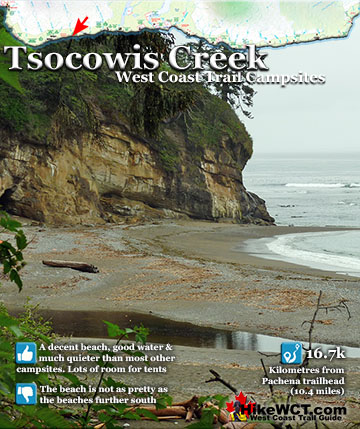
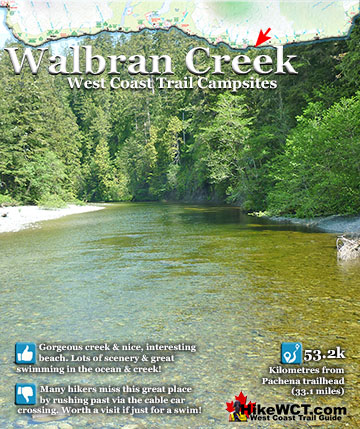
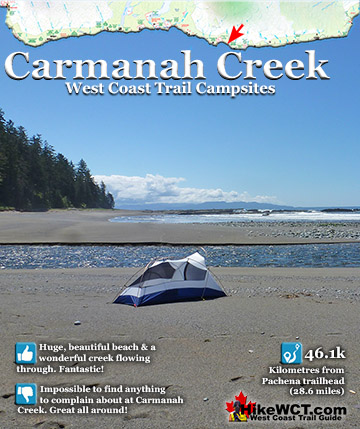
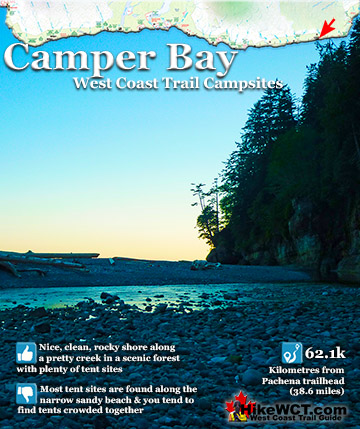
West Coast Trail A to Z

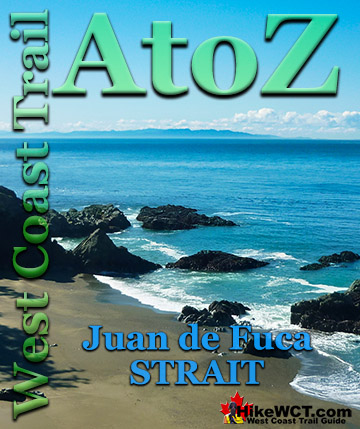
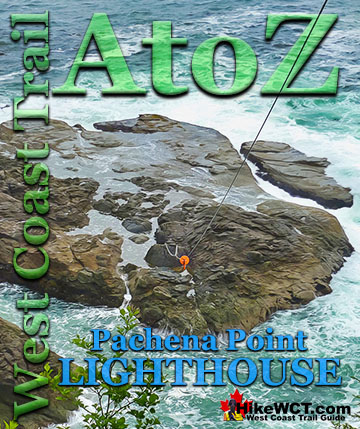
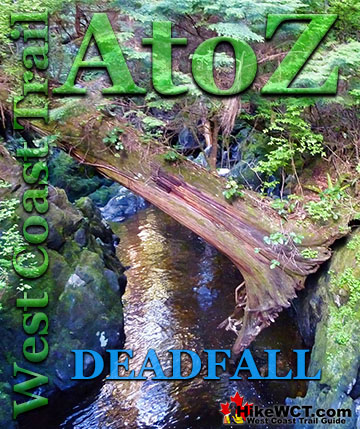
The West Coast Trail by Day
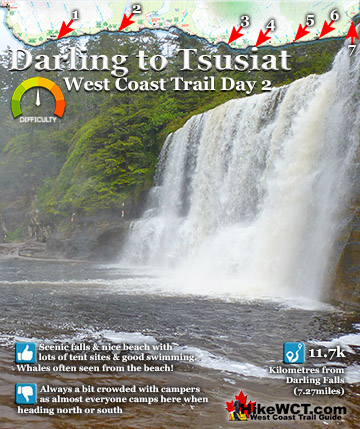
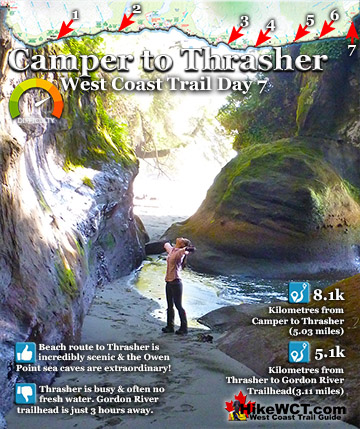
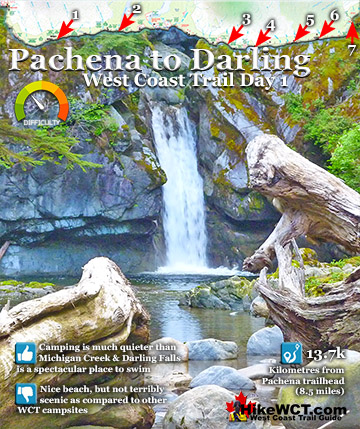
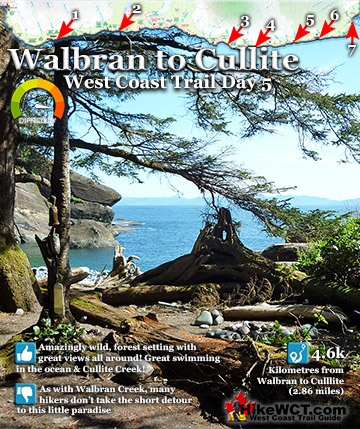
Explore BC Hiking Destinations!
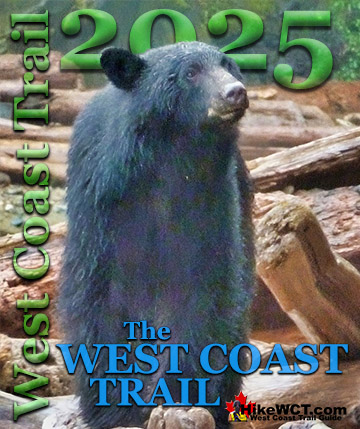
The West Coast Trail
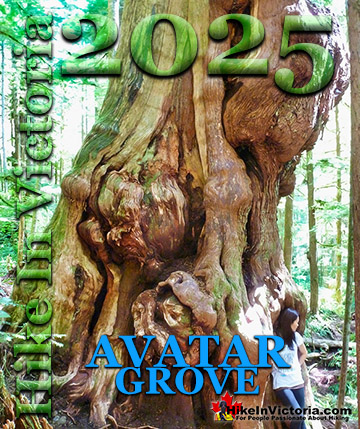
Victoria Hiking Trails
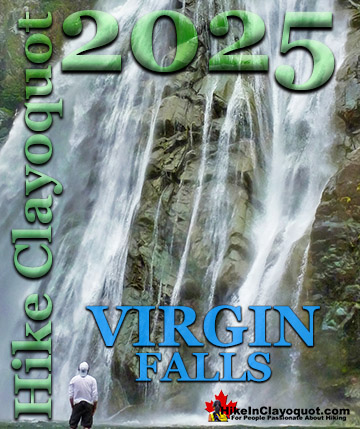
Clayoquot Hiking Trails
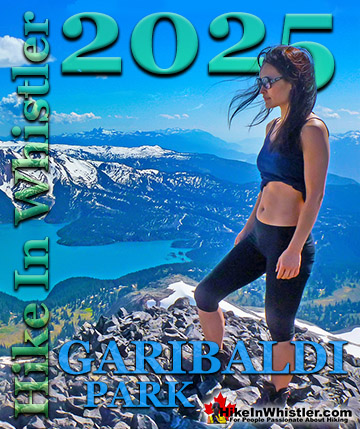
Whistler Hiking Trails
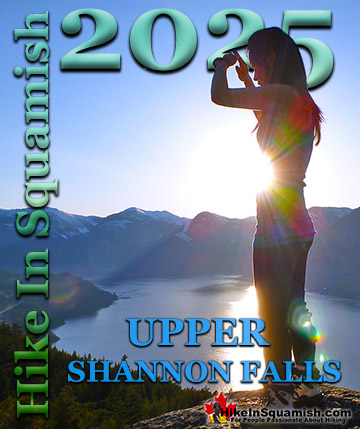
Squamish Hiking Trails

Vancouver Hiking Trails

